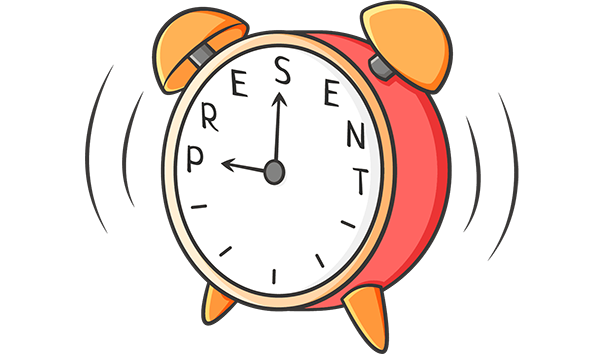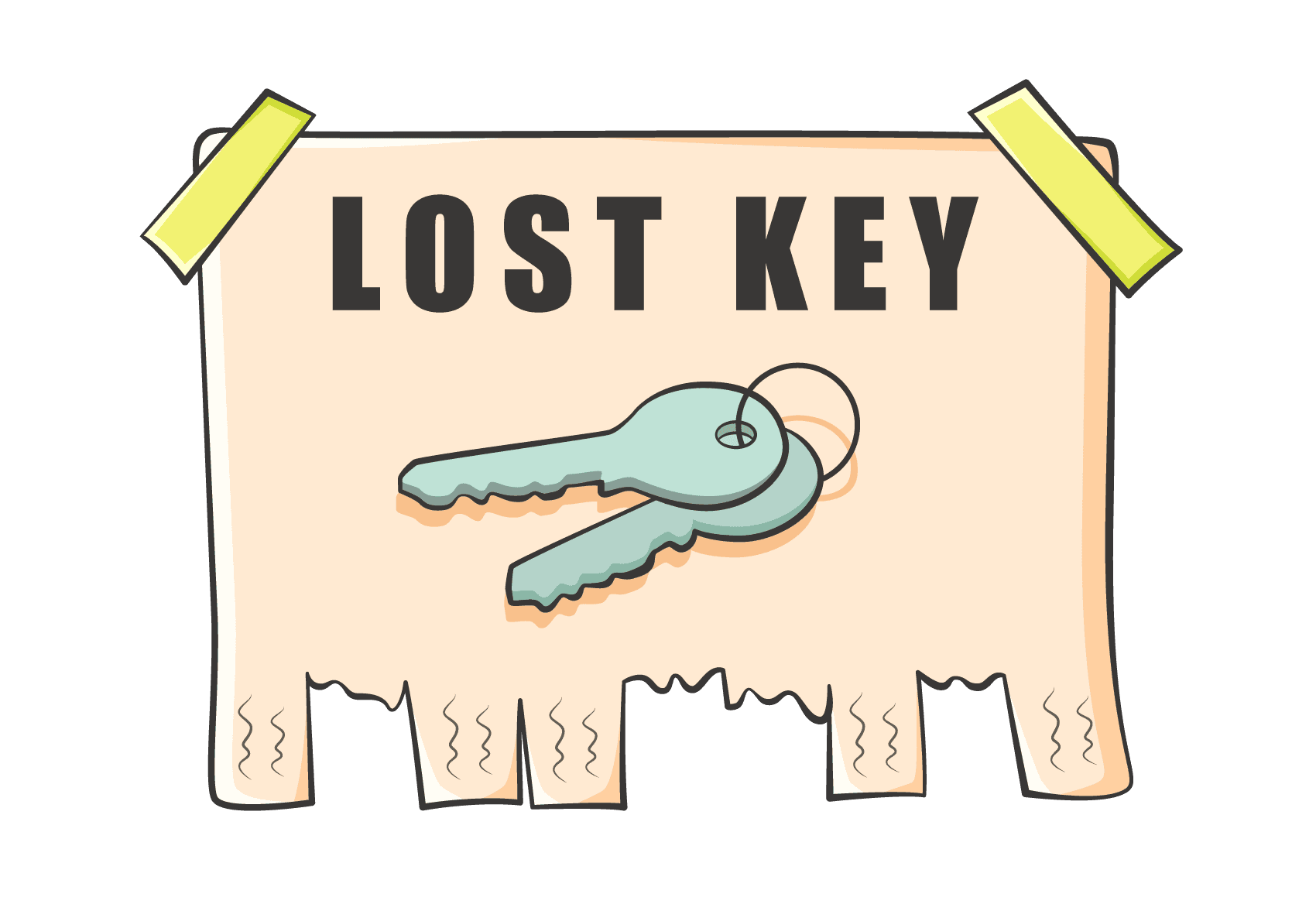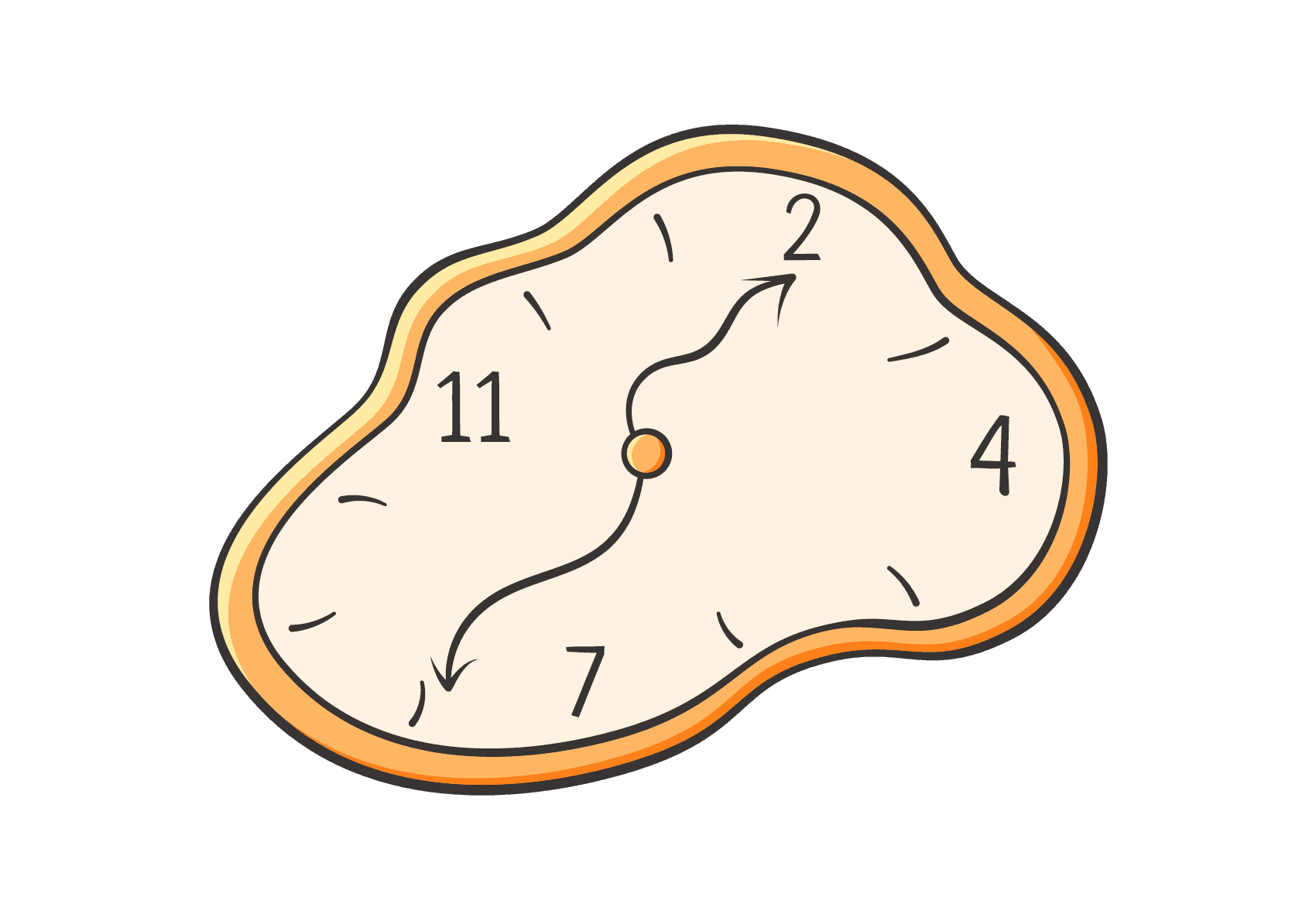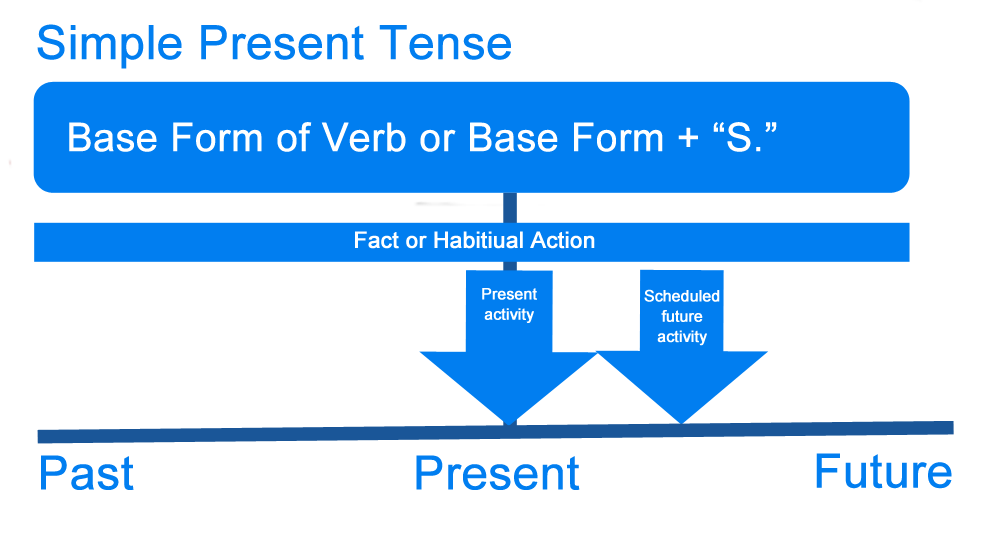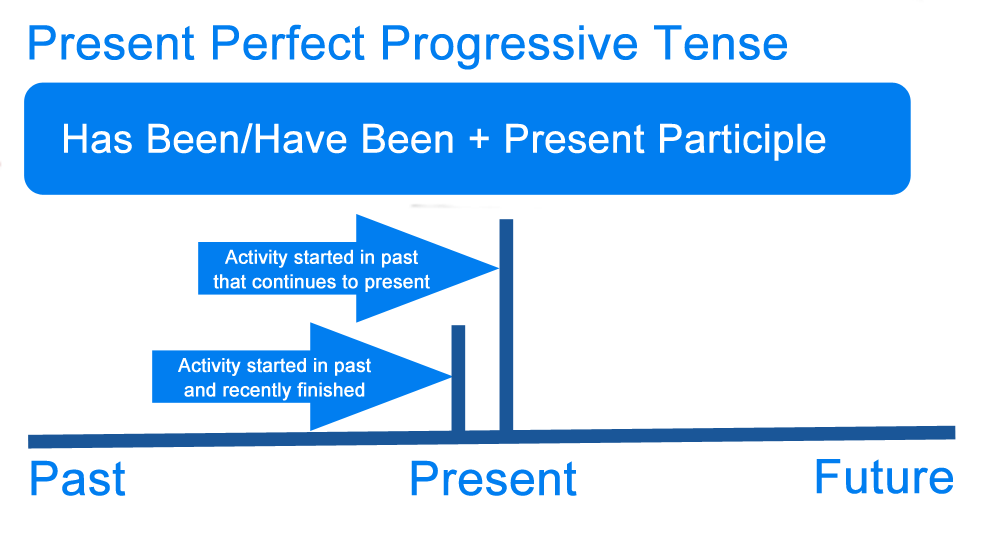В этой статье мы изучим времена группы Present, их функции и правила употребления.
Содержание:
- 1. Present Simple — простое настоящее время
- 2. Present Continuous — настоящее длительное время
- 3. Present Perfect — настоящее совершенное время
- 4. Present Perfect Continuous — настоящее совершенное длительное время
Настоящее время описывает действие, которые происходит сейчас или каким-то образом связано с настоящим моментом. В английском языке существует четыре формы настоящего времени — Present Simple, Present Continuous, Present Perfect и Present Perfect Continuous.
Present Simple — простое настоящее время
Грамматическое время Present Simple описывает привычные действия, которые повторяются с какой-то периодичностью (например, каждый день, редко или часто). О случаях использования Present Simple мы поговорим чуть позже, а пока давайте ознакомимся с правилами его образования.
Утвердительное предложение в Present Simple
I/You/We/They + основная форма глагола
He/She/It + основная форма глагола + окончание -s (-es)
I want to send her a postcard. I always do it when I’m on holiday. — Я хочу отправить ей открытку. Я всегда так делаю, когда я в отпуске.
Dad washes his car twice a week. — Папа моет машину дважды в неделю.
Отрицательное предложение в Present Simple
I/You/We/They + do not (don’t) + основная форма глагола
He/She/It + does not (doesn’t) + основная форма глагола
They don’t watch TV because they think there’s nothing good there. — Они не смотрят телевизор, потому что думают, что там нет ничего хорошего.
Alice doesn’t play volleyball. — Элис не играет в волейбол.
Вопросительное предложение в Present Simple
Do + I/you/we/they + основная форма глагола
Does + he/she/it + основная форма глагола
Do you work on weekends? — Ты работаешь по выходным?
Does he drive to work? — Он ездит на машине на работу?
Случаи использования Present Simple:
- Повторяющиеся события, ежедневная рутина.
He works as a model and he travels a lot for work. — Он работает моделью и много путешествует по работе.
Almost every day I have the same breakfast — a cup of coffee and a cheese sandwich. — Практически каждый день я завтракаю одинаково — чашка кофе и бутерброд с сыром. - Законы природы, общеизвестные факты.
The Earth rotates around the Sun at the speed of 30 km/s. — Земля вращается вокруг солнца со скоростью 30 км/c.
Water freezes when the temperature is below zero. — Вода замерзает, когда температура ниже нуля. - Действия, которые происходят по расписанию.
The film starts at 7 o’clock. — Фильм начинается в 7 часов.
The train arrives early in the morning. — Поезд прибывает рано утром. - Спортивные комментарии, обзоры, рецензии.
Johnson delivers a pass, Davis dribbles and scores a goal. — Джонсон делает пас, Дэвис ведет мяч и забивает гол.
Meryl Streep plays Aunt March in the new film version of Little Women. — Мэрил Стрип играет тетушку Марч в новой версии фильма «Маленькие женщины».С Present Simple обычно используются словосочетания, которые указывают, как часто происходит какое-то действие:
every day/evening — каждое день/вечер
every month/year — каждый месяц/год
twice/three times a week — два/три раза в неделюЧаще всего они ставятся в конце предложения.
They visit their grandparents every weekend. — Они проведывают дедушку и бабушку каждые выходные.
I go to Taekwondo classes twice a week. — Я хожу на занятия по тхэквондо дважды в неделю.Словами-маркерами Present Simple также могут быть наречия частоты, обычно они ставятся перед основным глаголом:
always — всегда
usually — обычно
often — часто
sometimes — иногда
rarely — редко
hardly ever — почти никогда
never — никогдаThey always find a reason to argue. — Они всегда находят причину поссориться.
Mary often performs in front of her classmates. — Мэри часто выступает перед одноклассниками.
Present Continuous — настоящее длительное время
Грамматическое время Present Continuous описывает длительное действие в настоящем или будущем.
Утвердительное предложение в Present Continuous
I + am + основная форма глагола с окончанием -ing
He/She/It + is + основная форма глагола с окончанием -ing
You/We/They + are + основная форма глагола с окончанием -ing
Dogs are barking. I can’t fall asleep. — Собаки лают. Я не могу уснуть.
Look! She is walking right over there! — Смотри! Она идет вон там!
Отрицательное предложение в Present Continuous
I + am not (I’m not) + основная форма глагола с окончанием -ing
He/She/It + is not (isn’t) + основная форма глагола с окончанием -ing
You/We/They + are not (aren’t) + основная форма глагола с окончанием -ing
It’s 11 p.m. and they are not sleeping! — Сейчас 11 часов, а они не спят!
We are not talking about Laura at the moment. — В данный момент мы не говорим о Лоре.
Вопросительное предложение в Present Continuous
Am + I + основная форма глагола с окончанием -ing
Is + he/she/it + основная форма глагола с окончанием -ing
Are + you/we/they + основная форма глагола с окончанием -ing
Are you working or I can talk to you right now? — Ты работаешь или я могу с тобой поговорить сейчас?
Is she getting dressed? I can’t wait anymore! — Она одевается? Я уже не могу ждать!
Основные случаи использования Present Continuous:
- Длительные действия, которые происходят непосредственно в момент речи. Основные слова-маркеры — now (сейчас) и at the moment (в данный момент).
The kids are having dinner now. Let’s talk to them a bit later. — Дети ужинают сейчас. Давай поговорим с ними немного позже.
I am finishing my presentation at the moment. I’ll be free in 5 minutes. — Я заканчиваю свою презентацию сейчас. Буду свободна через 5 минут. - Действия, которые носят временной характер.
She isn’t working this week. — Она не работает на этой неделе.
They are looking for a new shop assistant. — Они ищут нового продавца. - Действия, которые показывают изменение или развитие ситуации. Они чаще всего выражены глаголами to get (достигать), to become (становиться), to change (меняться), to increase (увеличиваться, возрастать).
My daughter is getting more and more curious about science. — Моя дочь все больше и больше интересуется наукой.
The world population is increasing really fast. — Мировое население увеличивается очень быстро. - Часто повторяющиеся действия, в отношении которых мы хотим выразить свою критику или раздражение. Словами-маркерами в данном случае будут always (всегда), constantly (постоянно), continually (все время, беспрестанно).
He is always talking like he knows everything about me! But it’s not true! — Он всегда говорит так, будто знает обо мне все! Но это не так!
You are constantly coming 15 minutes later! — Ты постоянно приходишь на 15 минут позже! - Запланированные действия, которые произойдут в ближайшем будущем (известна дата или место события).
I am going on a business trip to Washington next month. — Я еду в командировку в Вашингтон в следующем месяце.
My family is coming this weekend. I’ll have to buy some food. — Моя семья приезжает на этих выходных. Я должен купить еды.
Для того чтобы не бояться никаких времен в английском и употреблять их с легкостью, пройдите наш курс «Практическая грамматика».
Present Perfect — настоящее совершенное время
В русском языке не существует аналога времени Present Perfect, поэтому при его изучении часто возникает много вопросов. Давайте попробуем разобраться, как и когда его использовать и почему его относят к группе настоящих времен в английском языке. Начнем с правил его образования:
Утвердительное предложение в Present Perfect
I/You/We/They + have + глагол в 3-й форме или с окончанием -ed
He/She/It + has + глагол в 3-й форме или с окончанием -ed
I have just finished cooking. — Я только что закончила готовить.
She has found a new job. — Она нашла новую работу.
Отрицательное предложение в Present Perfect
I/You/We/They + have not (haven’t) + глагол в 3-й форме или с окончанием -ed
He/She/It + has not (hasn’t) + глагол в 3-й форме или с окончанием -ed
Henry and Sofia have not come yet. — Генри и София еще не пришли.
She hasn’t replied to my message. — Она не ответила на мое сообщение.
Вопросительное предложение в Present Perfect
Have + I/you/we/they + глагол в 3-й форме или с окончанием -ed
Has + he/she/it + глагол в 3-й форме или с окончанием -ed
Have you ever thought of living alone? — Ты когда-нибудь думал о том, чтобы пожить одному?
Has she applied for a visa? — Она подала заявку на визу?
Обратите внимание, с Present Perfect используются следующие слова-маркеры:
already — уже
just — только что
yet — еще (в отрицательных и вопросительных предложениях)
ever — когда-либо (в вопросительных предложениях)
never — никогда
lately/recently — в последнее время
for — на протяжении какого-то времени
since — с какого-то момента
Слова already, just, ever, never ставим между вспомогательным и основным глаголом; yet, lately и recently — в конце предложения; for и since — в конце предложения перед указанием времени.
Случаи использования Present Perfect:
- Действие, которое недавно завершилось и его результат виден или важен в настоящем.
My son has tidied his room. — Мой сын убрал свою комнату. (он уже закончил убирать, и мы видим результат — чистая комната)
She has already found the keys. Let’s go. — Она уже нашла ключи. Пойдем. - Действие, которое уже произошло, но нам важно не когда именно, а сам факт его свершения.
She has started writing a new book. — Она начала писать новую книгу. (в настоящем продолжает над ней работать)
- Действие, которое описывает личный опыт или перемены.
I have never taken this train to work. — Я никогда не ездила на этом поезде на работу.
Have you ever lived abroad? — Ты когда-нибудь жил за границей?
I’ve lost a couple of kilos for the past week. — Я скинул пару килограмм за последнюю неделю. - Действие, которое началось какое-то время назад и все еще продолжается в настоящем. В этом случае Present Perfect используется с глаголами состояния, например: to be (быть), to have (иметь), to like (нравится), to know (знать), to hear (слышать), to see (видеть), to believe (верить) и словами-маркерами for и since.
I have not heard from them since Friday. — Я от них ничего не слышал с пятницы.
They have had this car for 20 years. — У них эта машина уже 20 лет.
Police officers have known about this tragedy for half a year. — Полицейские знают об этой трагедии полгода как.
Present Perfect Continuous — настоящее совершенное длительное время
В отличие от Present Perfect, где важен результат, время Present Perfect Continuous делает акцент на продолжительности действия. Это время образуется согласно следующим правилам:
Утвердительное предложение в Present Perfect Continuous
I/You/We/They + have been + основная форма глагола с окончанием -ing
He/She/It + has been + основная форма глагола с окончанием -ing
We have been discussing it since morning. Let’s have a break. — Мы обсуждаем это с самого утра. Давайте сделаем перерыв.
She has been dating Alan for a year. — Она встречается с Аланом один год.
Отрицательное предложение в Present Perfect Continuous
I/You/We/They + have not (haven’t) been + основная форма глагола с окончанием -ing
He/She/It + has not (hasn’t) been + основная форма глагола с окончанием -ing
I have not been sleeping properly for the whole week. — Я не сплю нормально целую неделю.
They haven’t been doing their homework this month. — Они не выполняют домашние задания в этом месяце.
Вопросительное предложение в Present Perfect Continuous
Have + I/you/we/they + been + основная форма глагола с окончанием -ing
Has + he/she/it +been + основная форма глагола с окончанием -ing
Has he been sleeping for 10 hours? — Он что, проспал 10 часов?
Has she been cooking all morning? — Она готовила все утро?
Используем Present Perfect Continuous в следующих случаях:
- Действие, которое началось в прошлом и все еще продолжается в настоящем. Акцент на длительности.
I have been trying to find a new job for several months. But they just don’t want to hire me! — Я пытаюсь найти работу уже несколько месяцев. Они просто не хотят меня нанимать! (я начал искать несколько месяцев назад и все еще продолжаю это делать).
- Действие, которое продолжалось какое-то время и закончилось к моменту речи о нем с определенным результатом.
I have been climbing this mountain for 5 hours! I’m absolutely exhausted. — Я поднимался на эту гору 5 часов! Я совершенно измотан. (я уже закончил подъем и в результате этого очень устал)
- Когда нужно выразить злость или раздражение.
You have been speaking ill of me behind my back! — Ты плохо говорил обо мне за моей спиной!
She has been stealing secret data all this time! — Она воровала секретные данные все это время! - В вопросительных предложениях, которые начинаются с how long (как долго, сколько).
How long has she been writing this email? — Как долго она пишет письмо?
Мы разобрали все времена группы Present. Давайте сравним основные случаи их употребления в таблице ниже.
| Время | Случаи использования | Пример |
|---|---|---|
| Present Simple | – повторяющиеся действия, ежедневная рутина – законы природы, общеизвестные факты – действия, которые происходят по расписанию – спортивные комментарии, обзоры, рецензии |
She goes to the church every Sunday. — Она ходит в церковь каждое воскресенье.
Elephants live in Africa. — Слоны живут в Африке. The show starts at 9 p.m. — Шоу начнется в 9 часов. And they win Wimbledon! — И они выигрывают Уимблдонский турнир! |
| Present Continuous | – длительные действия, которые происходят в момент речи – временные действия – действия, которые показывают изменение или развитие ситуации – часто повторяющиеся действия, в отношении которых мы хотим выразить свою критику или раздражение – запланированные действия, которые произойдут в ближайшем будущем (известна дата или место события) |
You are smoking in a non-smoking area. — Вы курите в месте, не предназначенном для курения
We are looking for a new office manager. — Мы ищем нового офис-менеджера. Your English is getting much better. — Твой английский становится гораздо лучше. You are constantly losing your keys! — Ты постоянно теряешь свои ключи! They are starting a new course next week. — Они начинают новый курс на следующей неделе. |
| Present Perfect | – действие, которое недавно завершилось и его результат виден или важен в настоящем – действие, которое уже произошло, но нам важно не когда именно, а сам факт его свершения – действие, которое описывает личный опыт или перемены – действие, которое началось какое-то время назад и все еще продолжается в настоящем (только с глаголами состояния) |
I have just finished all paperwork. — Я как раз закончила всю бумажную работу.
He has bought a new car. — Он купил новую машину. I’ve never tried mango before. — Я раньше никогда не пробовала манго. She has known Mr. Black for 45 years. — Она знает мистера Блэка 45 лет. |
| Present Perfect Continuous | – действие, которое началось в прошлом и все еще продолжается в настоящем (акцент на длительности) – действие, которое продолжалось какое-то время и закончилось к моменту речи о нем с определенным результатом – когда нужно выразить злость или раздражение – в вопросительных предложениях, которые начинаются с how long |
They have been working on this contract since Monday. — Они работают над этим контрактом с понедельника.
She has been writing a diploma for several months. — Она писала диплом на протяжении нескольких месяцев. Who has been using my toothbrush?! — Кто пользовался моей зубной щеткой?! How long have you been living in LA? — Как долго вы живете в Лос-Анджелесе? |
Довести употребление английских времен до автоматизма можно на уроках с одним из наших опытных преподавателей.
Надеемся, теперь вам стало понятнее, чем одна форма настоящего времени отличается от другой. Предлагаем пройти небольшой тест, чтобы закрепить материал.
Тест по теме «Настоящее время в английском языке»
© 2023 englex.ru, копирование материалов возможно только при указании прямой активной ссылки на первоисточник.
The present tense is one of the three main verb tenses in the English language, alongside the past tense and the future tense. This explanation will introduce the present tense and its uses, define the four different types of the present tense, and provide plenty of examples.
What is the present tense?
The present tense is a grammatical tense primarily used to discuss actions and events occurring at the present time. However, these aren’t its only functions.
The main functions of the present tense are:
-
Describing actions and events which happen in the present — e.g. I’m looking for my glasses, have you seen them?
-
For reoccurring or habitual actions/events — e.g. I normally go to the cafe on the river.
-
Connect past events with the present — e.g. I’ve seen that film before.
-
Telling jokes or retelling events — e.g. A man walks into a bar …
-
Talking about the future — e.g. I’m seeing John next week.
-
Describing states — e.g. I live in Mexico.
Let’s look at a few examples in detail.
A. Today is my birthday.
B. My Birthday is on the 25th of September.
C. I have been celebrating.
The examples above all use the present tense but for different reasons. Example A uses the present tense because it is describing an event that is happening in the present. On the other hand, example B uses the present tense because it is talking about a reoccurring event that happens every year. Example C describes an action that began in the past but continues in the present.
The present tense is divided into four aspects (sometimes named ‘forms’), creating the present simple tense, the present continuous (or progressive) tense, the present perfect tense, and the present perfect continuous (or progressive) tense.
We will cover each of these tenses in more detail shortly, but first, let’s look at some examples of present tense sentences.

Present tense sentence examples
Here is a list of some present tense sentences.
-
Everyone is heading downstairs.
-
Emily takes piano lessons every Tuesday.
-
I am talking on the phone.
-
I go to France every year.
Types of present tense
Simply put, the types of present tense include simple present tense and present continuous. There are also a few other present tenses in English, such as present perfect and present perfect continuous, but these are more complex tenses and are used to describe actions that started in the past and continue up to the present moment.
However, each of the three main tenses (past, present, and future) is divided into four aspects. An aspect is a verb form concerned with time and indicates the completion, duration, or repetition of an action.
The four aspects are simple, progressive (continuous), perfect, and perfect progressive (continuous).
Christmas is on the 25th of December
Here the present simple tense is used to show a repeated event.
She is writing.
Here the present continuous tense is used to show that the action is ongoing and not yet complete.
I have eaten already, thanks
The present perfect tense is used here to show that a past event (eating) has an effect on the present.
I have been working since 9 am.
Here the present perfect continuous tense is used to connect an event that started in the past, to the present. We can see that the action (working) is ongoing and not yet completed.
Here is a handy table outlining the four present tenses and how they are used:
| Present simple | I write a letter. |
| Present progressive (continuous) | I am writing a letter. |
| Present perfect | I have written a letter. |
| Present perfect progressive (continuous) | I have been writing a letter. |
In the next section, we will outline each of these tenses and provide you with the formula for creating them. The next section will also give you some example sentences of the tenses in their positive, negative, and interrogative forms.
Present simple tense
The present simple tense is one of the most common and easy to understand tenses. It has two main uses: to discuss something that is happening in the present or to discuss something that happens regularly.
You can form the present simple tense by using this formula:
Subject + root form of the verb (+ s/es for third-person singular)
A. I‘m sorry.
B. She is happy.
C. Amy goes swimming every day.
Examples A and B tell us about something that is happening in the present, whereas example 3 tells us about a recurring event.
| Positive | I am happy. |
| Negative | I’m not happy. |
| Interrogative | Are you happy? |
Present continuous (progressive) tense
We use the present continuous (progressive) tense to talk about actions happening at the time of speaking that haven’t yet been completed. For example, ‘I am learning about the present tense’.
We can also use the present progressive tense to discuss fixed future plans or arrangements. For example, ‘We’re going to Brighton next weekend’.
You can use this formula to form the present progressive (continuous) tense:
subject + verb ‘to be’ + base verb + ing (sometimes called the present participle)
A. They are eating at Nandos.
B. She is talking with her friends.
C. Next week, we are visiting our grandparents.
Notice how all of the verbs end with -ing. This helps us recognise that the present continuous tense is being used. In examples A and B, the verbs eating and talking show us that the action is ongoing and not yet completed. In example 3, the present continuous tense has been used to discuss a fixed future plan.
| Positive | I am writing |
| Negative | I’m not writing |
| Interrogative | Are you writing? |
There are some verbs that we cannot use in the progressive tense. These are named stative verbs. Stative verbs are usually for abstract concepts, such as feelings and senses, rather than actions. In this case, we would use the present simple verb form instead. For example, we say ‘I believe you.’ rather than ‘I am believing you.’
Present perfect tense
The present perfect tense is used to connect an action or event that happened in the past with the present. The timing of the action or event is usually unspecified.
We often use the present perfect tense to talk about things that have happened in an unfinished time period (i.e. the day, the week, the year, a lifetime).
For example, ‘Today, I have eaten a burger and a salad.’ The present perfect tense has been used here because the day is not yet over. Once the day is over, the tense changes to ‘Yesterday, I ate a hamburger and a salad.’ This is because the past tense is used for completed actions in the past.
We can also the present perfect to describe actions or events that have just finished. We do this by adding the words just, recently, or already. For example, ‘I have just finished my lunch.’
To form the present perfect, you can use this formula:
Subject + have/has + past participle
A. I have written ten emails today.
B. He has been ill since Tuesday.
C. We have eaten curry before.
Notice how each sentence uses the past participle verb form (or verb form number 3, as it is sometimes called). In the example sentences, the part participle verbs are written, been, and eaten. We always use past participles when forming perfect tenses.
| Positive | I have eaten |
| Negative | I haven’t eaten |
| Interrogative | Have you eaten? |

Present perfect continuous (progressive) tense
This is the final present verb tense. The present perfect continuous tense (also known as present perfect progressive tense) shows us that something started in the past and is continuing into the present time.
To form the present perfect progressive tense, you can use this formula:
subject + has/have been + base verb + ing (present participle)
A. I have been reading my textbook for a week now.
B. I haven’t been feeling great lately.
C. Ben has been arriving to work late recently.
All of the examples above tell us about actions that started in the past and are still ongoing. Look at example B, we know that the speaker has been feeling unwell recently and still feels unwell now.
It is common to use the words lately and recently when using the present perfect continuous tense.
| Positive | I have been eating. |
| Negative | I haven’t been eating |
| Interrogative | Have you been eating? |
Remember how we mentioned stative verbs above? As this is a continuous tense, we must remember to think about stative verbs here as well. When using a verb that cannot be used in the continuous aspect, we use the present perfect tense instead. For example, we say ‘He has owned a car since August’ (present perfect tense), rather than ‘He has been owning a car since August.’
Present perfect vs present perfect continuous
The difference between the present perfect (simple) and present perfect continuous can be a little tricky to understand. We use both of these verb forms to talk about actions or states that started in the past and have some connection to the present. However, there are a few key differences.
The present perfect usually focuses on the result of an action in some way, whereas the present perfect progressive focuses more on the action itself.
‘I’ve cleaned the kitchen, it looks great! ‘ (present perfect tense)
Here the present perfect is used to focus on the result of the action, the clean kitchen.
‘I’ve been cleaning the kitchen for hours! ‘ (present perfect continuous tense)
Here the present perfect progressive is used to focus on the duration of the action (cleaning).
The present perfect tense is also more commonly used to describe an action that is completed, while the present perfect continuous is used to talk about actions that are ongoing and may continue into the future.
‘I‘ve made your lunch.’ (present perfect)
Here the present perfect tense is used because the action has been completed.
‘I have been making your lunch since 11 am.’ (present perfect continuous)
Here, the present perfect continuous is used because the action is ongoing.
Using the present tense to talk about the future
You may be surprised to hear that we almost always use the present tense to talk about the future. In fact, some grammarians argue that there is no ‘future tense’ in English, just ways of ‘expressing the future’. This is because there is no unique way of adapting verbs to reflect the future (i.e. we don’t use verb inflections).
However, the future tense is now widely considered one of the three main verb tenses in English.
Using the present simple to talk about the future
We use the present simple to discuss events in the future that will definitely happen — either because they’re facts or because there is a timetable/schedule.
A. The train arrives at 2 pm.
B. Emily has an appointment tomorrow.
Example A uses the present tense as the train arrives in accordance with a timetable, whereas example B uses the present tense because it is a fact that Emily has an appointment for tomorrow (note — whether or not Emily attends the appointment doesn’t change the fact that it has been booked).
Using the present continuous tense to talk about the future
As previously mentioned, we use the present continuous to talk about fixed future plans.
A. We’re going to France tomorrow.
B. I’m leaving at 1 pm.
Using auxiliary verbs to talk about the future
Auxiliary verbs are sometimes referred to as ‘helping verbs’ because they help modify the main verb. In this case, we use auxiliary verbs to help change the main verb into the future tense.
The main auxiliary verbs we use are will and (is/am/are) going to.
See how the future tense has been created from the present tense by adding an auxiliary verb before the main verb (will).
Using the present tense to talk about the past
We often use the present tense when talking about things in the past. This is most common in storytelling, joke-telling and news reporting. Many authors will also use the present tense in their writing to immerse the reader in the ‘now’ of the story.
We also use the present tense when reporting speech.
A. German leader resigns.
B. So, I met this woman and she says to me, ‘Can I buy you a drink?’
C. In 1918 the war ends and an election takes place.
Present Tense — Key takeaways
-
The present tense is one of the three main verb tenses in English.
- The present tense is used to discuss actions and events happening in the present, to discuss reoccurring events, to connect past events with the present, and to discuss the future and the past.
-
The present tense contains four aspects: present (simple), present continuous (or progressive), present perfect, and present perfect continuous (progressive).
-
The present tense is one of the most commonly used tenses in spoken English.
Present tense definition: The present tense signals an action that is currently going on or habitually performed.
What does past tense mean? The present tense of verbs expresses events or actions that are occurring now, relative to the speaker—or to actions that are habitually performed and may not necessarily be happening right now.
These actions are general truths or they are happening now.
Present Tense Forms
There are four forms of the present tense. They include:
- simple present
- He jumps.
- present progressive
- He is jumping.
- present perfect
- He has jumped.
- present perfect progressive
- I have been jumping.
Four Types of Present Tense
What is a present tense verb? Here are the four present tenses in English. We have definitions and examples of each so you can learn past tense.
What is the Simple Present?
What is the simple present tense? The simple present is generally used for actions that are factual, normal, or regular in occurrence, sometimes called habitual actions. Habitual actions are actions that occur in the present but are not necessarily happening right now.
To form the simple present:
- Subject + base form of verb
- add “s” to third person singular
Example:
- Handy, a 46-year-old who works answering phones at a car service, has been raising her family alone for nearly a decade, enduring constant financial hardship and even tragedy. –CBS News
The simple present is used to express:
- facts, truths
- Shane lives in Canada.
- routines
- Shane washes his car on Sundays.
- states of being
- Shane is happy.
- events that are certain or cannot be changed
- The meeting starts at noon.
- future events
- Shane works tonight.
What is the Present Progressive Tense?
What does present progressive mean? The present progressive expresses actions that are happening now or that are in progress.
To form the present progressive:
- Subject + am/is/are + present participle (and “-ing” to end of the verb)
Example:
- The feeling around the team is that White is going to prove to be worth the wait. –NBC Sports
The present progressive is used to express:
- actions that are happening now
- Emmet is watching television.
- actions that are in progress
- They are completing a project together.
The present progressive can also be used for future events.
- Subject + am/are + going + infinitive
- I am going to wash the car tomorrow.
What is the Present Perfect Tense?
What does present perfect tense mean? The present perfect tense expresses actions that happened at time that is not specific and actions that started in the past but continue to the present.
To form the present perfect:
- Subject + has/had + past participle of verb
The present perfect is used to express:
- actions in the past of indefinite time
- I have traveled to Paris.
- actions that started in the past but continue to present
- My mom has been a clerk her entire professional career.
What is the Present Perfect Progressive?
What does present perfect progressive mean? The present perfect progressive tense expresses actions that began in the past and continue to the present and actions that have recently stopped.
To form the present perfect progressive:
- Subject + has/had + been + present participle (and “-ing” to end of the verb)
The present perfect progressive is used to express:
- actions that began in the past but continue to present
- The baby has been crying for hours.
- actions that have recently stopped
- I have been waiting for you.
Other English Tenses

What is the Past Tense?
What does past tense mean? In general, the past tense expresses events that have occurred before now.
- They cleaned up after dinner.
- John rode his bike to work.
What is the Future Tense?
What does future tense mean? In general, future tense expresses actions that will occur at a future date.
- She will attend high school next year.
- They will live happily ever after.
Summary: What is the Present Tense?
Define present tense: In grammar, the definition of present tense is a tense signaling an action that is currently going on or habitually performed.
In summary, the present tense:
- is used to express actions that occur now
- has four forms including: simple, present perfect, present progressive, and present perfect progressive
Contents
- 1 What is Present Tense in English?
- 2 Present Tense Forms
- 3 Four Types of Present Tense
- 4 What is the Simple Present?
- 5 What is the Present Progressive Tense?
- 6 What is the Present Perfect Tense?
- 7 What is the Present Perfect Progressive?
- 8 Other English Tenses
- 9 What is the Past Tense?
- 10 What is the Future Tense?
- 11 Summary: What is the Present Tense?
Take a quick moment to think about all of the things that are happening around you right now. If you’re inside, maybe a radio is playing music. Or maybe someone has been mowing their lawn for the past couple of hours. If you’re outside, you might see a car drive by. Or maybe some people on the street have walked past you.
Regardless of what is going on, we can use words called verbs to refer to all of the actions and states we see happening around us. We actually use four different types of verb tenses to say something about the present.
So, let’s not waste any more time and learn more about the group we call present tense verbs right now!
What is a present tense verb?
Generally speaking, we use present tense verbs to say that an action or state happens in the current moment. However, because grammar can never make things easy on us, present tense verbs don’t always talk about the present. Sometimes, we can even use types of present tense to say that something also happened in the past or may even happen in the future.
Verbs are used in the present tense for many different reasons. Some of these reasons include:
- Describing events or states that are happening in the present (right now)
- Saying that events or states happen regularly or routinely
- Stating facts, beliefs, or opinions
- Describing events or states that began in the past and continue into the present
- Referring to events or states that are in progress in the present and will continue into the future
- Stating that an event or state is planned to happen in the future
- Saying that something is currently in progress
- Stating that something began a while ago but still continues to happen at the current time
Take a look at the simplest sentence that still perplexes many: It is I vs. It’s me. Which one is correct?
The four types of present tense verbs
In English, we use four different types of present tenses. Here we provide names and examples of each of the types of present tense.
Simple present tense:
- The cat hates me.
- They want cake.
- She exercises every day.
Present perfect tense:
- He has cooked bacon three times today.
- The dogs have chased their tails for hours.
- I have seen this movie before.
Present continuous tense:
- I am waiting for the mail.
- He is living life to the fullest.
- She is looking for a roommate.
Present perfect continuous tense:
- I have been coughing all morning.
- Jasmine has been texting for hours.
- Billy has been studying biology since he was a kid.
Simple present tense
The simple present tense uses the root form of the verb except when the subject is in the third person. The simple present tense has several different uses:
Actions/states occurring in the present:
- James lifts weights while Heather uses the treadmill.
- This fish smells like an old boot.
Actions/states that happen regularly:
- I read books every night.
- He is always angry.
Stating facts:
- Dogs are mammals.
- LeBron James plays basketball.
Expressing opinions or beliefs:
- My dad is a cool dude.
- Kittens are really cute.
It all starts with the simplest of them all, the simple present. Learn more about it here.
Present perfect tense
The present perfect tense uses the verb have or has with the past participle of the verb (for regular verbs, ending in -ed, -d, or -t). This tense is used to describe actions or states that connect the past to the present. For example:
- She has slept all day. (She was sleeping in the past and she is still sleeping now)
- We have read every book in this library. (We are currently standing in the same library that houses the books we read in the past)
- You have asked me that same question 10 times already. (You are asking me the same question now that you asked repeatedly in the past)
Present continuous tense
The present continuous tense uses present tense forms of the verb be with the present participle of the verb (ending in –ing). This tense also has a few different uses:
Actions happening now that will continue in the future:
- I am working on my masterpiece.
- Her annoying cat is yowling loudly.
Actions that are planned for the future:
- I am going to Denmark next week.
- My friends are coming to my house tonight.
Present perfect continuous tense
The present perfect continuous tense uses the phrase have/has been followed by the present participle of the verb (ending in –ing). This tense is used to indicate that an action began in the past, has continued to happen up until the current moment, and will likely continue to happen into the future. Here are examples of sentences that use the present perfect continuous tense:
- I have been playing the piano since I was a little kid.
- Haruto has been living in Tokyo for seven years.
- Patrick and Bob have been raking leaves all morning.
Be present and take this quiz on present tense verbs.
No time like the present to improve your writing!
You won’t mistake your verb tenses again when you check your writing on Thesaurus.com’s Grammar Coach™. This writing tool uses machine learning technology uniquely designed to catch grammar and spelling errors. Its Synonym Swap will find the best nouns, adjectives, and more to help say what you really mean, guiding you toward clearer, stronger, writing.
Whether you’re writing about the past, present, or future, start writing smarter today!

